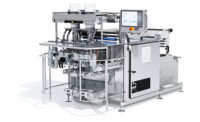Single Smarts
By Renee M. Covino
Single and carefree? Not when it comes to candy
singles. A front-end expert offers advice on how to best manage this
significant subset.
The single life of a candy bar is far from free-wheeling. Some would even argue there is a serious science behind the front-end placement of these single impulse packs of joy.
“My work is all about immediate consumption and
helping retailers drive basket size,” says Cam Cloeter, a
self-proclaimed “space doctor” of front-end merchandise
(particularly in supermarkets). Candy singles are a very important subset
of the total front-end business, comprising about one-third, or 30-33
percent, according to Cloeter, whose formal title is president of Impulse
Marketing, based in Long Valley, N.J.
|
Cloeter works with some major candy brands and with
retailers to get more shopper “converts” to buy these immediate
consumption items at the front end. “The people that convert tend to
convert over and over,” he says.
So in the case of candy singles, what placement
strategies get the conversion job done?
Customer left. This
strategy has retailers moving certain confectionery singles “over the
belt” to a customer’s left as he or she is checking out.
Working with one major manufacturer, Cloeter discovered that moving gum and
mints over the belt grew them by 15 percent. “The average gum and
mint customer takes about 12 seconds to make a decision whether to buy or
not,” Cloeter states. “On the other hand, magazines, which are
often merchandised at customer left, take 53 seconds — why do that
over the belt when customers don’t have that kind of time?” He
adds that “customers don’t have eyes in the back of their
heads, and when they’re putting their items on the belt, they
can’t see the candy items on the right.”
High right. This
strategy works well with chocolate, and merely involves moving it up higher
on the right side of the front-end set. Once again, Cloeter discovered a 15
percent growth in sales if this method is employed. “All too often,
you see chocolate singles like Reese’s and Kit Kat down on the right
rack, when we, adults, don’t like to bend low like that,”
Cloeter explains. “If they’d put it at eye level more often, we
will respond and convert.”
With both the “customer left” and
“high right” merchandising ideas, “sales of singles are
increased without changing price or adding space,” Cloeter reminds.
“Retailers can improve the visibility and accessibility of these
items; they can improve confectionery at the front end by 15 percent just
with these alone.”
Forget alternating variety. Another key merchandising strategy for the most effective
sales in front-end candy singles is to keep sets consistent from aisle to
aisle. “If you want to drive conversion and basket sales, take the
top 30 or 40 candy items and put them in every single lane, rather than
alternating variety,” advises Cloeter. “Customers determine
check lanes by the shortest lines. Seventy-five percent do not shop across
lanes so retailers who sprinkle around variety for more sales —
it’s a bad idea. They might think they’re doing a good thing,
when in actuality, they’re hurting themselves.”
The reason for this rationale is that, unfortunately,
there is very limited check-lane space. “If there were such things as
70-foot lanes, retailers could put more stuff up there, and play around
with variety,” he adds. “But most check-stands are only 75-100
inches in total length — and in that, a retailer has to fit
magazines, beverages, gum and mints, and candy.” And the candy has
the most competition from the beverage category. That category is
“exploding” right now thanks to the proliferation of bottled
water and iced tea SKUs, among others, Cloeter maintains.
But consider some under-penetrated segments. “I do think there are candy categories up at the
front that are under-penetrated,” Cloeter reveals. Primarily what
he’s referring to are premium chocolate and kids’ candy.
“It’s no secret that the big guys with
national sales forces tend to dominate the space up there so companies like
Ferrero or Topps really struggle with their couple of SKUs,” he says.
“They really get pushed around by the biggies.”
Based on some of Cloeter’s newest work currently
underway, he thinks “there’s an exciting opportunity to bring
another sub-category or two to the front end,” particularly with
what’s going on with dark chocolate, “which I think is here to
stay,” he says, and with non-chocolate kids’ items, which tend
to be under-penetrated because they are not represented by the biggest
manufacturers, according to him.
| Top 20 Candy Singles
in C-Stores For 52 weeks ending August 17, 2006 |
||
| Item | Unit Volume (in millions) | % Change (vs. prior year) |
| 1. Snickers | 11.4 | 1.4% |
| 2. Snickers King-Size | 7.7 | 2.7% |
| 3. Reese’s Peanut Butter Cup King-Size | 7.7 | 6.2% |
| 4. Reese’s Peanut Butter Cup 1.5 oz. | 7.1 | 0.4% |
| 5. M&M’s Peanut | 5.5 | 1.8% |
| 6. M&M’s Peanut King-Size | 4.9 | 6.0% |
| 7. Hershey's Milk Chocolate | 4.2 | -5.6% |
| 8. Twix | 4.2 | -1.1% |
| 9. 3 Musketeers | 4.0 | 5.1% |
| 10. Hershey Almond King-Size | 4.0 | 7.6% |
| 11. Hershey Almond | 3.8 | -10.3% |
| 12. Twix King-Size | 3.5 | 6.6% |
| 13. Kit Kat | 3.4 | -6.4% |
| 14. M&M’s Plain | 3.3 | -3.3% |
| 15. Skittles | 3.0 | -0.4% |
| 16. Milky Way | 3.0 | -0.2% |
| 17. Hershey Milk Chocolate King-Size | 2.9 | 14.3% |
| 18. Starburst | 2.9 | 12.2% |
| 19. Take 5 | 1.7 | -43.1% |
| 20. Butterfinger | 1.4 | -48.8% |
| SOURCE: McLane Company Inc. | ||
Don’t leave out self-checkout. Self-checkout is affecting the front-end business in an
“enormous way,” according to Cloeter, because those who use
this means to get through the lines “tend to be the ones with the
smallest baskets and are the most frequent shoppers. Those are exactly the customers you want to present with items
they can buy everyday,” he explains, “but more often than not,
there’s nothing there for them to buy.”
Best practices for retailers with self-checkouts
include putting in single candy items and other front-end merchandise on a
merchandiser between the front-most checkout lanes, Cloeter reveals.
“It becomes almost like a traffic-flow monitor,” he says.
“It ends up being like a gate or a fork in the road for customers to
choose which self-checkout side they should go on, the right or the left,
but meanwhile, the middle merchandiser is like a free-for-all.”
His research reveals that 13 feet from left to right is
the minimum amount of space that should be allowed for this self-checkout
middle merchandiser. The best news of all: “It gets back 80 percent
of the front-end sales,” according to Cloeter.
| Candy and Snack Singles in C-Stores Ranked in order of greatest to least growth for 52 weeks ending August 17, 2006 |
||
| Category | Unit Volume (in millions) | % Change (vs. prior year) |
| CANDY | ||
| Gum | 144.7 | 2.4% |
| Chocolate Bars | 176.9 | 1.2% |
| Premium | 9.7 | -4.0% |
| Non-Chocolate Bars | 73.0 | -5.1% |
| Candy Rolls (including Mints and Drops) | 23.8 | -7.9% |
| Changemakers | 22.0 | -14.8% |
| SNACKS | ||
| Other Salty Snacks | 11.6 | 27.9% |
| Nuts-Seeds | 35.3 | 19.1% |
| Crackers | 16.6 | 7.2% |
| Cookies | 28.8 | 1.5% |
| Energy Snacks | 22.8 | -3.0% |
|



